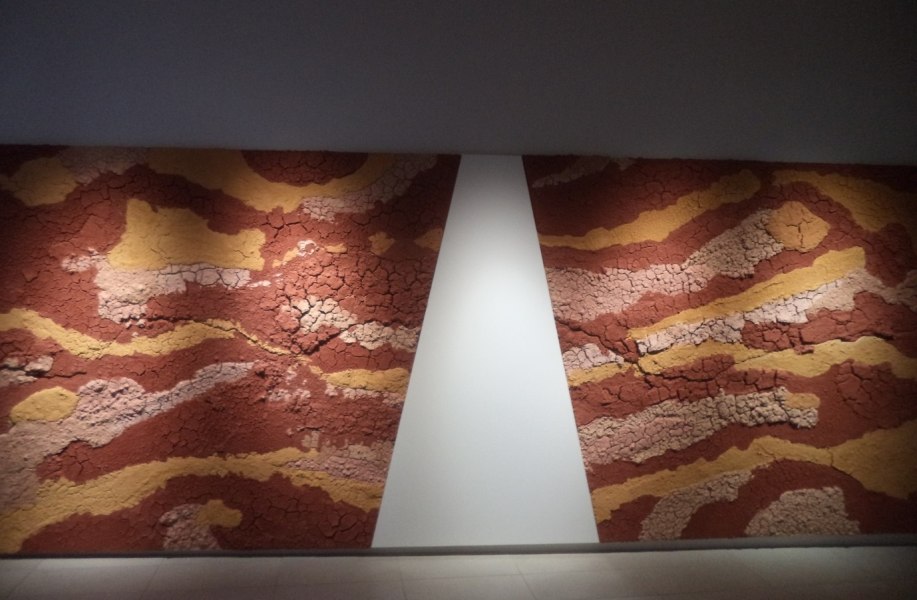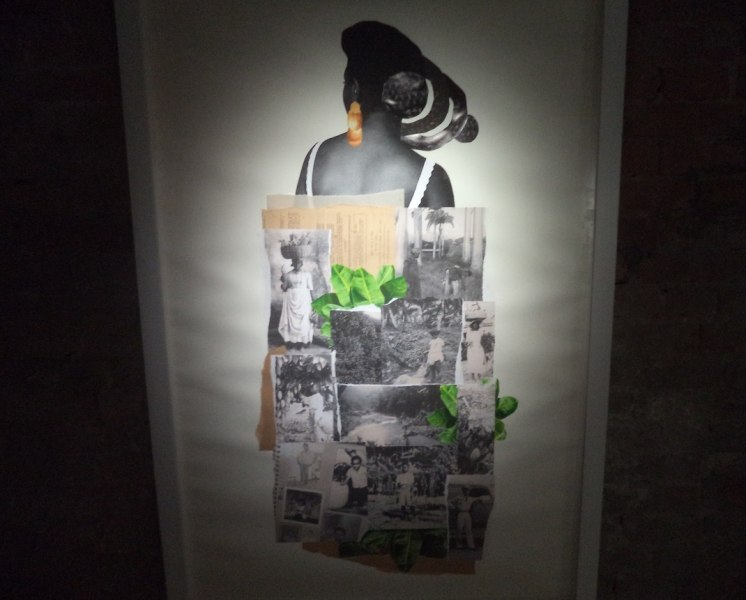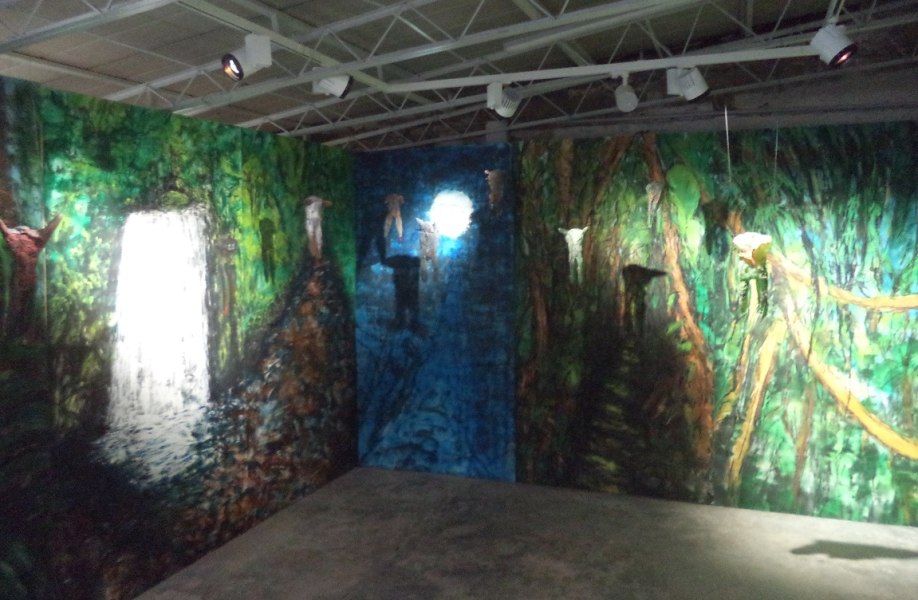Alla Biennale di Venezia, presso lo Spazio “Castello 2131”, è visitabile il Padiglione Nazionale di Panama, avente le opere degli artisti Brooke Alfaro, Isabel De Obaldia, Cisco Merel e Giana De Dier. Esteticamente, pare che a loro prema un sorvolo sulla stilizzazione, ma per “crocifiggere” il naif. Sotto la curatela di Ana Elizabeth Gonzalez con Monica Kupfer, la mostra è stata denominata Traces: on the body and on the land. Quella riguarda opere differenti: a disegno, ad installazione, a scultura, a dipinto, a collage. Dal canto suo, il visitatore occidentale deve sensibilizzarsi: per via d’un problema sociale.
Fra il Panama e la Colombia, esiste una “strettoia” intercontinentale che si chiama Tapon del Darien. Lì, la foresta pluviale “magicamente” si percepisce a tal punto impenetrabile da aver sempre impedito l’auspicabile completamento per la comodità moderna d’una Strada Panamericana. Quindi bisognerebbe che si volasse, o che si navigasse. Da una parte ci stanno i turisti (i quali possono pagare); dall’altra parte ci stanno i migranti (con la loro disperazione). Gli esploratori si doteranno almeno d’un fuoristrada o d’una motocicletta, pur valutando i classici imprevisti del caso (fra le forature ed i ribaltamenti). I migranti già spenderanno lo scarso denaro a disposizione per l’aereo verso l’Ecuador, sfruttandone il liberalismo sui visti.
Il Tapon del Darien ha i sentieri fangosi che stilizzano le nervature delle foglie: pure lo stivale fungerebbe da machete. In natura l’innocenza non è mai esotica, per chi rischia di morire invadendo volontariamente un regno di serpenti, rane, ragni, coccodrilli ecc… I migranti, agognando di raggiungere la libertà degli Stati Uniti, potrebbero almeno cercarsi l’aiuto d’una guida locale. Però il Tapon del Darien è controllato dalle milizie paramilitari (spesso e paradossalmente d’ideologia comunista), e dai narcotrafficanti, i quali hanno la base politica in Colombia. Ne soffre dapprima la popolazione indigena, che già combatte le speculazioni urbanistiche sul prolungamento della Strada Panamericana. La biodiversità “si stilizza” proteggendosi col parco naturale, dall’ambientalismo. Quello fu istituito dal Panama, diventando in seguito un patrimonio dell’umanità. Ma la canopia nella sua libertà “crocifigge” lo scudo improvvisato (per necessità). Sotto il caldo torrido, si potrà morire per la disidratazione (anche perché non esistono i punti di ristoro). Il tentativo d’aggirare la foresta, passando dal Mar dei Caraibi, a certi turisti dà la naupatia, tramite le piccole lance che impiegano parecchie ore.
Non vale l’esotismo, che per il consumismo occidentale sarebbe pregiudiziale addirittura cavalcando l’illegalità, se la Colombia oggigiorno prova, dopo decenni di guerre civili, ad abbandonare la piaga d’una connivenza con la “libertà” del narcotraffico. Questo rischia di diventare un mero pretesto per il nazionalismo politico fra il Panama e gli Stati Uniti. Installando delle barriere sui valichi dei sentieri, ufficialmente per colpire il narcotraffico, si scoraggerebbero le migrazioni. Però il famoso Canale di Panama fu costruito (sotto la continuità secolare d’una protezione finanziaria da parte degli Stati Uniti) per facilitare la connessione intercontinentale. Il Tapon del Darien sembra un “calmiere” per l’egoismo del libero mercato. Non vi transitano le ricche navi, bensì le persone povere. La buona politica deve accettare e stemperare la contraddizione sociale. I migranti, che in maniera fortunosa sopravvivono alla pericolosa giungla, non sono collusi coi narcotrafficanti, bensì sfruttati da questi (per un passaggio). Secoli fa si diffuse l’arcaismo un po’ naif per il mito del buon selvaggio. Nel Tapon del Darien, il capitalismo occidentale “è sporcato” dalla criminalità per il traffico di organi, che sfrutta le persone povere. Evitando il sorvolo degli elicotteri militari, forse gli indigeni ci ricorderanno quello delle case sugli alberi. Una loro alleanza coi migranti permetterà il progressismo dell’ospitalità, senza il pregiudizio per il nazionalismo della terra.
A Venezia, Isabel De Obaldia ha esibito l’installazione a tecnica mista che si chiama Selva. Esteticamente, a lei interessa la spettralità claustrofobica. Alle pareti, è stata disegnata la giungla. Il verde del fogliame impenetrabile porta un grigiore alla luce trasfigurante, realisticamente dal caldo umido. Le liane più grosse ed i sentieri più larghi sarebbero stati sorvolati, per un “alpinismo” paradossalmente verso l’inferno. Infatti l’artista ha appeso dei manichini smembrati, ed in crocifissione. L’azzurro marino mancherebbe, rimpiazzato da quello d’una caverna. Il palombaro paralizza il nuotatore, paradossalmente migliorando la respirazione. Isabel De Obaldia per le sue sculture sceglie il vetro. Così nella giungla l’aria paralizza l’acqua, perché l’umidità si percepisce abissale. I toni sgargianti detergono mostruosamente la pelle, complice una spugnosità dallo sventramento. Al fine d’aggirare i sentieri, i fiumi si riveleranno torbidi. L’unico elemento potenzialmente demandato ad abbellire, ossia la cascata, si “macellerebbe” al crepaccio ghiacciato. Il folletto dovrebbe nascondersi, come il pipistrello. Isabel De Obaldia appende i propri manichini tagliandovi la testa, le braccia, le mani ed i piedi. In Oriente il pipistrello simboleggia la fortuna. Dall’America Latina la patata si diffuse in Europa, ma associandosi addirittura alla stregoneria, dopo che i conquistadores l’avevano candidata con poca nobiltà, al fine d’alimentare gli animali. E’ così che noi potremmo trasfigurare i manichini dell’artista. Vi appaiono anche i germogli. Naturalmente, la memoria dei conquistadores ci conferma la drammaticità, rispetto all’attualità delle migrazioni.
Nei dipinti di Brooke Alfaro, sono rappresentati gli ambienti acquatici. Si riconoscono le diverse imbarcazioni che dovrebbero consentire la conquista d’una terra vivibile, da parte dei migranti. C’è una drammaticità esplicita, fra paesaggi che potrebbero universalizzarsi (al di là del Panama), per via del simbolismo. Ad esempio la calca dei migranti imbarcati è destinata al naufragio, non rispettando la statica. Questo diventa infernale, quantunque all’interno dell’innocenza selvatica. Brooke Alfaro cerca paradossalmente la stilizzazione carnosa, secondo la pittura sudamericana. Magari oggi i migranti mitizzano l’opulenza degli Stati Uniti, che non sembrano più interessati a governare da soli il mondo, divenuto multipolare. Tuttavia al nazionalismo perdura il rischio dell’insensibilità, a causa della xenofobia. Nel quadro dal titolo Hibiscus Saint, forse si tradisce il simbolismo della fecondità. Qualcuno si tuffa, e tuttavia condanna alla caducità l’aureola celeste, fra gli spruzzi nell’acqua torbida. Non può esserci un divertimento… L’eventuale dragaggio concernerebbe le ossa! Nel quadro dal titolo The earth shook and the sea raged, subentra forse una “vendetta” della Natura contro la falsa “superbia” dell’uomo. Lì, la calca dei migranti imbarcati si percepisce cominciando ad ardere, col grigio, la gigantografia d’un “polmone corallino” (a prescindere dalla reale carnagione). L’unico “appiglio” di luce, per la resistenza d’una candela sulla risalita dalla cenere abissale, appartiene ad una grande croce. Quella svetta da uno scoglio perfino “imbellettata” dalle lampadine d’un rosso sgargiante. Noi non dobbiamo mai dimenticare l’importanza che riveste l’ecosistema della foresta pluviale, nella gestione degli scambi fra l’ossigeno e l’anidride carbonica.
A Venezia, Cisco Merel esibisce un grande quadro a tecnica mista, provando a tappezzare i pigmenti. Essa s’intitola Mirages of the gap. L’astrattismo di Vasilij Kandinskij è citato mediante la spiritualità d’un triangolo che “scende sulla terra”, acquisendo un orizzonte cardinale, al trapezio. Nel Tapon del Darien, i migranti devono barcamenarsi nella pedana di lancio verso l’agognata libertà, negli Stati Uniti. Serve il machete, per tagliare la fitta vegetazione, in caso di pericoloso smarrimento. Non c’è il sentiero regolarmente curato, coi segnavia. Cisco Merel ha incastrato la “pedana” d’un triangolo fra gli ondeggiamenti del fango pigmentato, col rosso e l’ocra del sole umido alleggeriti dal miraggio rosa d’un mimetismo per la pelle. Il sentiero è difficile da percorrere. Così il fango si percepirebbe ai “carboni ardenti” per la foglia, laddove l’umidità paradossalmente secca. Il triangolo centrale avanzerebbe al lamento d’una torcia mancante, per orientarsi. Le sabbie mobili seccano la sudorazione dovuta all’agitazione. C’è lo sforzo di liberarsi dall’inghiottimento, che mimetizza “falsamente”: verso la morte. I migranti sognerebbero di camminare sul “velluto rosa” della duna. Questa ingrandirebbe la conchiglia. Nella Bibbia, Mosè riuscì ad attraversare il mare che s’era miracolosamente ritirato per lui. Oggi il Vaticano non manca di ricordare le sofferenze dei migranti, pure nel Tapon del Darien.
Da una leggenda americana, un giorno la foresta sarebbe bruciata; ma soltanto il colibrì avrebbe rischiato la vita, caricandosi le gocce d’acqua fluviale, per lanciarle contro il fuoco. Il poeta Pablo Neruda nacque in Cile. A lui, il colibrì sembrava un arcobaleno vivente, per i colori sgargianti sulla “brace” delle ali. Esso si sarebbe originato quando la rosa si congelò in un pugno d’antracite. Il Cile ha abbondanza di risorse minerarie. Per Pablo Neruda, anticamente un “frammento gocciolante” dell’incendio terrestre sarebbe volato via, mentre i pesci (dal tono zaffiro per l’acqua) passavano “alla brace” le proprie squame, tramutandole in ali.
A Venezia, Giana De Dier esibisce il collage dal titolo Everything that is noble and true. Lei ricorda la migrazione afro-caraibica mentre si costruiva il Canale di Panama, all’inizio del Novecento. Le immagini d’epoca combattono contro la cartolina turistica. Anche le terze o quarte generazioni dei migranti devono “raccapezzarsi” in merito alla verità sulla “nobiltà” della propria origine. Così si giustificherebbero i toni chiaroscurali. L’accenno esotico, dalla foglia verde e dall’orecchino giallo, appesantisce come il lavoro nei campi con il cesto, rispetto al “colibrì” d’uno scatto, dal fotografo. Ma quanto il Panama avrebbe le “ali” dall’istmo? Realizzando un reportage, ci si sente un po’ in colpa perché si passa oltre rispetto all’opportunità d’un aiuto politico, contro la povertà o lo sfruttamento. Il collage di Giana De Dier si percepisce “allo spiedo” per la piantagione. Il negativo fotografico concernerebbe la fatica per un fardello. Sono raffigurate le schiene femminili. Da uno “spiedo” della bretella, il bianconero d’una “caffeomanzia” potrebbe avvisarci sull’aumento delle migrazioni, qualora il capitalismo occidentale non diventasse più solidale.
PANAMA HAS THE CAP WHICH CONTRADICTS THE CANAL FOR THE ISTHMUS
At the Venice Biennale, at the Spazio “Castello 2131”, we can visit the National Pavilion of Panama, which has the art works of Brooke Alfaro, Isabel De Obaldia, Cisco Merel and Giana De Dier. Aesthetically, it seems that they are interested in an overflight of the stylization, but to “crucify” the naif. Under the curatorship of Ana Elizabeth Gonzalez with Monica Kupfer, the exhibition was called Traces: on the body and on the land. That concerns different works: drawings, installations, sculptures, paintings, collages. For his part, the occidental visitor has to become sensitized: because of a social problem.
Between Panama and Colombia, an intercontinental “bottleneck” called Darien Gap exists. There, the rainforest “magically” is perceived to the point of impenetrability that it always forbade to complete favourably a Pan-American Highway, for a modern comfort. Therefore we should fly, or navigate. On one hand there are the tourists (who can pay); on the other hand there are the migrants (with their desperation). The explorers will equip themselves at least with an off-road vehicle or a motorcycle, albeit considering the typical relevant unexpected events (between the punctures and the overturnings). The migrants already would have spent the insufficient money available for the airplane into Ecuador, taking advantage of its liberalism about the visas.
The Darien Gap has the muddy paths which stylize the veins of the leaves: also the boot would function as a machete. In nature the innocence is never exotic, for somebody who risks to die invading voluntarily a reign of the snakes, the frogs, the spiders, the crocodiles etc… The migrants, yearning for the landing place in the freedom of the United States, could at least look for the help from a local guide. However the Darien Gap is controlled by the paramilitary militias (often and paradoxically with a communist ideology), and by the drug traffickers, who have the base in Colombia. Initially, about this, the indigenous population suffers, already fighting against the building speculations about the extension of the Pan-American Highway. The biodiversity “is stylized” protecting itself with a natural park, for the environmentalism. That was instituted in Panama, then becoming a world heritage site. But the canopy in its freedom “crucifies” an improvised shield (by necessity). Under the scorching heat, we could die of dehydration (also because the refreshment points are not present). The attempt to bypass the forest, passing from the Caribbean Sea, causes the naupathia to some tourists, through the small speed boats, which takes many hours.
The exoticism is not valid; this one, according to the occidental consumerism, would be prejudicial even riding the illegality, if Colombia nowadays tries, after decades of civil wars, to abandon the plague of a connivance with the “freedom” of the drug trafficking. This risks to become a mere excuse for a political nationalism between Panama and the United States. Installing some barriers on the passages of the paths, officially to damage the drug trafficking, the migrations would be dissuaded. However the famous Panama Canal was built (under the centennial continuity of a financial protection by the United States) to facilitate an intercontinental connection. The Darien Gap seems a “price control” for the egoism of the free market. There the rich ships don’t pass through, because poor people pass through. The good politics has to accept and moderate the social contradiction. The migrants, who fortunately survive a dangerous jungle, are not colluded with the drug traffickers, but alienated by these one (for a lift). Centuries ago an archaism a bit naif for the myth of the noble savage spread. In the Darien Gap, the occidental capitalism “is dirtied” by the criminality about the organ trafficking, which alienates the poor people. Avoiding the overflight of the military helicopters, perhaps the indigenous people will recall for us the overflight of the tree houses. Their alliance with the migrants will allow the progressivism of the hospitality, without the prejudice about a nationalism for the land.
In Venice, Isabel De Obaldia exposed the mixed media installation called Selva. Aesthetically, she is interested in the claustrophobic ghostliness. On the walls, the jungle was drawn. The green of the impenetrable foliage leads the transfiguring light, realistically from the damp heat, to a greyness. The biggest lianas and the widest paths would have been under an overflight, for a “mountaineering” paradoxically into the hell. In fact the artist hanged some dismembered, and crucified, dummies. The blue of the sea would be lacking, replaced by the blue of a cave. The deep-sea diver paralyzes the swimmer, paradoxically improving the breathing. Isabel De Obaldia chooses the glass, for her sculptures. So in a jungle the air paralyzes the water, because the humidity is perceived as abyssal. The gaudy tones cleanse monstrously the skin, with the complicity of a sponginess from a disembowelment. To bypass the paths, the rivers will reveal as turbid. The only element potentially delegated to an embellishment, namely the waterfall, would “be slaughtered” in a frozen crevasse. The sprite should hide itself, like the bat. Isabel De Obaldia hangs the own dummies cutting there the head, the arms, the hands and the feet. In the East the bat symbolizes the luck. The potato spread from Latin America to Europe, but being associated even to a witchcraft, after its candidacy by the conquistadores as food for animals, with poor nobility. Exactly in this way we could transfigure the dummies of the artist. There also the sprouts appear. Of course, the memory about the conquistadores confirms to us the tragedy, compared to the current events about the migrations.
In the paintings of Brooke Alfaro, the aquatic environments are represented. We recognize the different boats which should allow the conquest of a livable land, by the migrants. There is an explicit tragedy, between the landscapes that could be universalized (beyond Panama), because of the symbolism. For example the crowd of the embarked migrants is destined to a shipwreck, not respecting the statics. This becomes infernal, although inside a wild innocence. Brooke Alfaro looks paradoxically for a fleshy stylization, according to the South American painting. Perhaps today the migrants mythicize the opulence of the Unites States, which no longer looks interested in governing alone the world, which has become multipolar. But with the nationalism we continue to risk to be insensitive, because of the xenophobia. In the picture called Hibiscus Saint, maybe the symbolism of the fertility is betrayed. Somebody dives, although he sentences the celestial halo to a caducity, between the splashes in the turbid water. A fun can not be present… The potential dredging would concern the bones! In the picture called The earth shook and the sea raged, maybe a revenge of the Nature, against the false “arrogance” of the men. There, the crowd of the embarked migrants is perceived starting to burn, with the grey, the blow-up of a “coral lung” (regardless of the real complexion). The only “handhold” of light, for the resistance of a candle which climbs back up from an abyssal ash, belongs to a big cross. This stands out from a rock even “embellished” by the light bulbs in a gaudy red. We must never forget the importance assumed by the ecosystem of a rainforest, about the management of the exchanges between the oxygen and the carbon dioxide.
In Venice, Cisco Merel shows a big mixed media picture, trying to upholster the pigments. It is called Mirages of the gap. The abstractionism of Wassily Kandinsky is mentioned through the spirituality of a triangle which “descends to earth”, acquiring a cardinal horizon, with a trapezoid. In the Darien Gap, the migrants have to get by in a launch pad into the long-awaited freedom, in the United States. The machete is necessary, to cut the thick vegetation, in the event of a dangerous loss. There is not a path regularly well-kept, with the trail signs. Cisco Merel wedged the “platform” of a triangle between the fluctuations of a pigmented mud, with the red and the ochre of a damp sun in the easing by the pink mirage of a camouflage for the skin. The path is difficult, about its journey. So the mud would be perceived at the “hot coals” for a leaf, where the humidity paradoxically dries out. The central triangle would move forward at the lament of a lacking torch, to orient yourself. The quicksands dry out the sweating provoked by an agitation. There is effort to release yourself from a swallowing, which camouflages “falsely”: into the death. The migrants would dream about walking on the “pink velvet” of a dune. This would enlarge a shell. From the Bible, Moses was able to cross the sea that miraculously retreated for him. Today Vatican does not fail to remember the pain of the migrants, also in the Darien Gap.
From an American tale, one day the forest would have burned; but only the hummingbird would have risked the life, taking on itself the drops of river water, to throw these against the fire. Poet Pablo Neruda was born in Chile. The hummingbird seemed to him a living rainbow, for the gaudy colours on the “embers” of the wings. It would have been originated when the rose froze in a fist of anthracite. Chile has an abundance of mineral resources. According to Pablo Neruda, in ancient times a “dripping fragment” of a terrestrial fire would have flown away, while the fish (with the sapphire tone for the water) passed “through the grill” the own scales, turning these into wings.
In Venice, Giana De Dier shows the collage called Everything that is noble and true. She remembers the Afro-Caribbean migration during the construction of the Panama Canal, at the beginning of ‘900. The vintage images fight against the holiday card. Also the third or the fourth generation of migrants has to “make sense” about the truth of the “nobility”, from the own origin. So we would justify the tones in chiaroscuro. An exotic hint, from the green leaf and the yellow earring, adds weight as the work in the fields with a basket, compared to a “hummingbird” of the shot, from the photographer. But how much will Panama have the wings from an isthmus? Realizing a reportage, we feel a little guilty because we move on compared to the opportunity of a political help, against the poverty or the exploitation. The Giana De Dier’s collage is perceived “on the spit” for a plantation. The photographic negative would concern the exertion for a bundle. The female backs are represented. From a “spit” of a strap, the black and white of a “coffee palmistry” could advise us about the increase of the migrations, if the occidental capitalism will not become more supportive.








